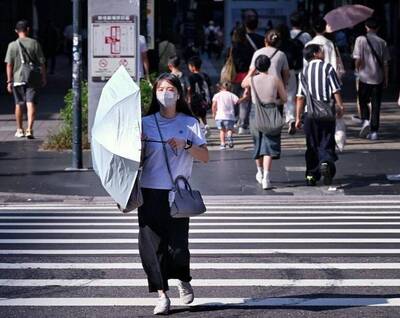With the scrub typhus season approaching, the Centers for Disease Control (CDC) yesterday advised people to cover up when sweeping tombs or doing other activities outdoors, as the fatality rate can be as high as 60 percent without proper treatment.
Cases of scrub typhus usually begin to increase in April and reach their peak in May or June, CDC Epidemic Intelligence Center Deputy Director Guo Hung-wei (郭宏偉) said.
As of Monday, 27 cases had been reported this year, with 12 of them occurring in Hualien and Taitung, CDC data showed.
Prior years had more cases in the same period — 43 cases in 2019 and 37 cases last year — with most of the infections occurring in Hualien, Taitung and the outlying islands, the data showed.
Scrub typhus is usually transmitted to humans when they are bitten by chiggers, or larval mites, that are infected with bacteria called Orientia tsutsugamushi, CDC physician Lin Yung-ching (林詠青) said.
Occurring nine to 12 days after a bite, scrub typhus symptoms can include fever, headache, enlarged lymph nodes, macular or maculopapular rash, and a dark and scab-like region at the site of the chigger bite, he said.
“Some of those infected might also experience coughing or pneumonia, and if the infection progresses untreated, organ failure,” Lin said. “The fatality rate can reach up to 60 percent, although it can drop below 5 percent if it is properly treated with antibiotics.”
Chiggers are typically in dense grass and bushes, and people can get bitten if they pass through the area, so the CDC advises people to wear light-colored clothing with long sleeves and long pants, and to apply insect repellent to exposed skin when participating in Tomb Sweeping Festival or other outdoor activities, he said.
Chiggers might be attached to people’s clothing if they have walked through grass and bushes, so they should take a bath and wash their clothes after walking through areas that might have the insects, Lin said.
If people think that they have scrub typhus symptoms, they should immediately seek medical attention, he added.

Three Taiwanese airlines have prohibited passengers from packing Bluetooth earbuds and their charger cases in checked luggage. EVA Air and Uni Air said that Bluetooth earbuds and charger cases are categorized as portable electronic devices, which should be switched off if they are placed in checked luggage based on international aviation safety regulations. They must not be in standby or sleep mode. However, as charging would continue when earbuds are placed in the charger cases, which would contravene international aviation regulations, their cases must be carried as hand luggage, they said. Tigerair Taiwan said that earbud charger cases are equipped

Foreign travelers entering Taiwan on a short layover via Taiwan Taoyuan International Airport are receiving NT$600 gift vouchers from yesterday, the Tourism Administration said, adding that it hopes the incentive would boost tourism consumption at the airport. The program, which allows travelers holding non-Taiwan passports who enter the country during a layover of up to 24 hours to claim a voucher, aims to promote attractions at the airport, the agency said in a statement on Friday. To participate, travelers must sign up on the campaign Web site, the agency said. They can then present their passport and boarding pass for their connecting international

Temperatures in northern Taiwan are forecast to reach as high as 30°C today, as an ongoing northeasterly seasonal wind system weakens, the Central Weather Administration (CWA) said. CWA forecaster Tseng Chao-cheng (曾昭誠) said yesterday that with the seasonal wind system weakening, warmer easterly winds would boost the temperature today. Daytime temperatures in northern Taiwan and Yilan County are expected to range from 28°C to 30°C today, up about 3°C from yesterday, Tseng said. According to the CWA, temperature highs in central and southern Taiwan could stay stable. However, the weather is expected to turn cooler starting tonight as the northeasterly wind system strengthens again

Taiwan sweltered through its hottest October on record, the Central Weather Administration (CWA) said yesterday, the latest in a string of global temperature records. The main island endured its highest average temperature since 1950, CWA forecaster Liu Pei-teng said. Temperatures the world over have soared in recent years as human-induced climate change contributes to ever more erratic weather patterns. Taiwan’s average temperature was 27.381°C as of Thursday, Liu said. Liu said the average could slip 0.1°C by the end of yesterday, but it would still be higher than the previous record of 27.009°C in 2016. "The temperature only started lowering around Oct. 18 or 19